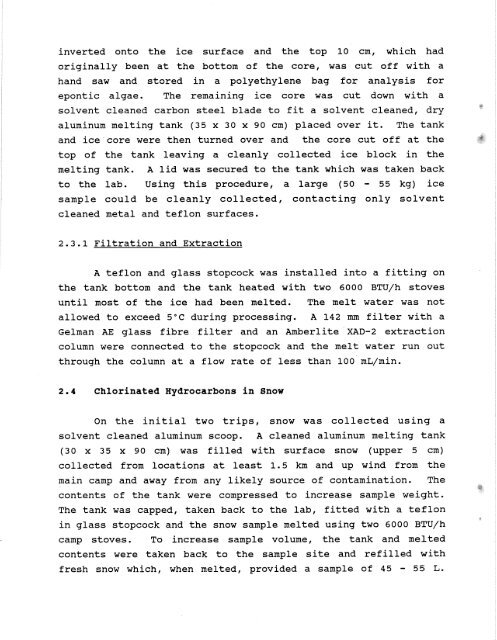Distribution of Chlorinated Hydrocarbon Pesticides and PCBs in the ...
Distribution of Chlorinated Hydrocarbon Pesticides and PCBs in the ...
Distribution of Chlorinated Hydrocarbon Pesticides and PCBs in the ...
Create successful ePaper yourself
Turn your PDF publications into a flip-book with our unique Google optimized e-Paper software.
<strong>in</strong>verted onto <strong>the</strong> ice surface <strong>and</strong> <strong>the</strong> top 10 cm, which had<br />
orig<strong>in</strong>ally been at <strong>the</strong> bottom <strong>of</strong> <strong>the</strong> core, was cut <strong>of</strong>f with a<br />
h<strong>and</strong> saw <strong>and</strong> stored <strong>in</strong> a polyethylene bag for analysis for<br />
epontic algae. The rema<strong>in</strong><strong>in</strong>g ice core was cut down with a<br />
solvent cleaned carbon steel blade to fit a solvent cleaned, dry<br />
alum<strong>in</strong>um melt<strong>in</strong>g tank (35 x 30 x 90 cm) placed over it. The tank<br />
<strong>and</strong> ice'core were <strong>the</strong>n turned over <strong>and</strong> <strong>the</strong> core cut <strong>of</strong>f at <strong>the</strong><br />
top <strong>of</strong> <strong>the</strong> tank leav<strong>in</strong>g a cleanly collected ice block <strong>in</strong> <strong>the</strong><br />
melt<strong>in</strong>g tank. A lid was secured to <strong>the</strong> tank which was taken back<br />
to <strong>the</strong> lab. Us<strong>in</strong>g this procedure, a large (50 - 55 kg) ice<br />
sample could be cleanly collected, contact<strong>in</strong>g only solvent<br />
cleaned metal <strong>and</strong> teflon surfaces.<br />
Filtration <strong>and</strong> Extraction<br />
A teflon <strong>and</strong> glass stopcock was <strong>in</strong>stalled <strong>in</strong>to a fitt<strong>in</strong>g on<br />
<strong>the</strong> tank bottom <strong>and</strong> <strong>the</strong> tank heated with two 6000 BTU/h stoves<br />
until most <strong>of</strong> <strong>the</strong> ice had been melted. The melt water was not<br />
allowed to exceed 5°C dur<strong>in</strong>g process<strong>in</strong>g. A 142 mm filter with a<br />
Gelman AE glass fibre filter <strong>and</strong> an Amberlite XAD-2 extraction<br />
column were connected to <strong>the</strong> stopcock <strong>and</strong> <strong>the</strong> melt water run out<br />
through <strong>the</strong> column at a flow rate <strong>of</strong> less than 100 mL/m<strong>in</strong>.<br />
2.4 <strong>Chlor<strong>in</strong>ated</strong> <strong>Hydrocarbon</strong>s <strong>in</strong> Snow<br />
On <strong>the</strong> <strong>in</strong>itial two trips, snow was collected us<strong>in</strong>g a<br />
solvent cleaned alum<strong>in</strong>um scoop. A cleaned alum<strong>in</strong>um melt<strong>in</strong>g tank<br />
(30 x 35 x 90 cm) was filled with surface snow (upper 5 cm)<br />
collected from locations at least 1.5 km <strong>and</strong> up w<strong>in</strong>d from <strong>the</strong><br />
ma<strong>in</strong> camp <strong>and</strong> away from any likely source <strong>of</strong> contam<strong>in</strong>ation. The<br />
contents <strong>of</strong> <strong>the</strong> tank were compressed to <strong>in</strong>crease sample weight.<br />
The tank was capped, taken back to <strong>the</strong> lab, fitted with a teflon<br />
<strong>in</strong> glass stopcock <strong>and</strong> <strong>the</strong> snow sample melted us<strong>in</strong>g two 6000 BTU/h<br />
camp stoves. To <strong>in</strong>crease sample volume, <strong>the</strong> tank <strong>and</strong> melted<br />
contents were taken back to <strong>the</strong> sample site <strong>and</strong> refilled with<br />
fresh snow which, when melted, provided a sample <strong>of</strong> 45 - 55 L.

















